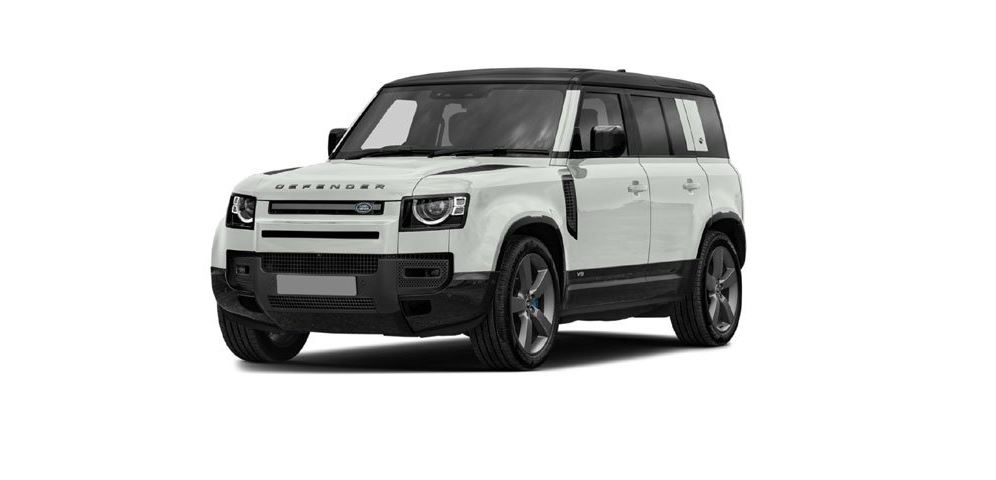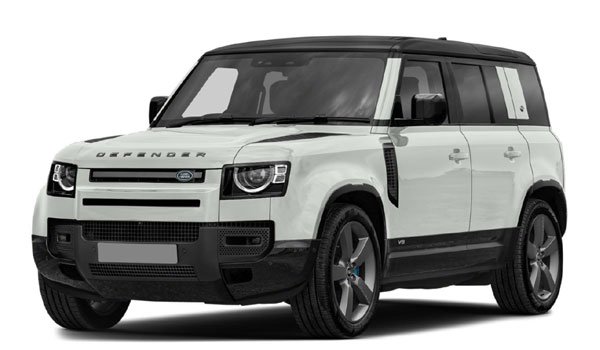 2023 Land Rover Defender Fluid Level Checks
2023 Land Rover Defender Fluid Level Checks
FLUID FILLER LOCATIONS
Always observe and follow the safety precautions when working in the engine compartment. Failure to do so may result in serious injury or death.
Do not start the engine, or drive the vehicle, if leaked fluid could possibly make contact with a hot surface. Any leaked fluid coming into contact with a hot surface, such as the exhaust, could result in combustion. Seek qualified assistance immediately.
Further information on safety precautions can be found in the relevant section of the Owner’s Handbook. See SAFETY IN THE GARAGE.
The brake fluid reservoir is always located on the driver’s side.
A number of simple checks and routine maintenance must be carried out at regular intervals. See WEEKLY CHECKS.
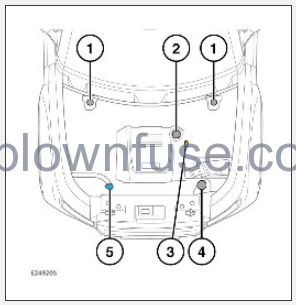
- Brake fluid reservoir cap.
- Engine oil filler cap.
- Engine oil level dipstick.
- Engine coolant reservoir filler cap.
- Washer fluid reservoir filler cap.
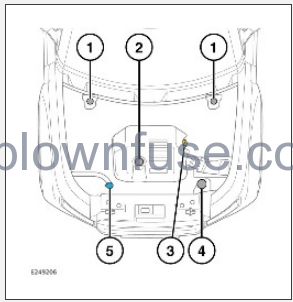
- Brake fluid reservoir cap.
- Engine oil filler cap.
- Engine oil level dipstick.
- Engine coolant reservoir filler cap.
- Washer fluid reservoir filler cap.
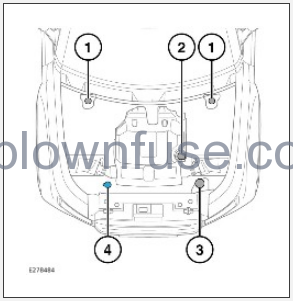
- Brake fluid reservoir cap.
- Engine oil filler cap.
- Engine coolant reservoir filler cap.
- Washer fluid reservoir filler cap.
The 5.0L petrol engine does not have an oil level dipstick. See CHECKING THE ENGINE OIL LEVEL.
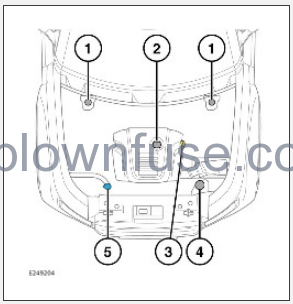
- Brake fluid reservoir cap.
- Engine oil filler cap.
- Engine oil level dipstick.
- Engine coolant reservoir filler cap.
- Washer fluid reservoir filler cap.
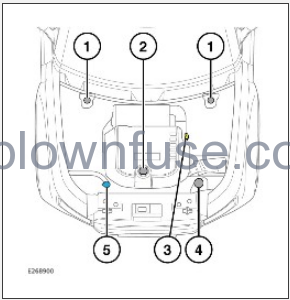
- Brake fluid reservoir cap.
- Engine oil filler cap.
- Engine oil level dipstick.
- Engine coolant reservoir filler cap.
- Washer fluid reservoir filler cap.
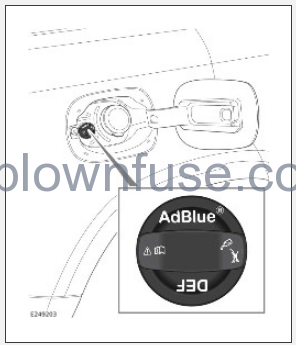
The Diesel Exhaust Fluid (DEF) tank filler cap is located inside the fuel filler flap, to the side of the fuel filler cap. See DIESEL EXHAUST FLUID (DEF).
CHECKING THE ENGINE OIL LEVEL
Check the engine oil weekly. If any significant or sudden drop in the engine oil level is noted, seek qualified assistance.
If the instrument panel displays the message Add 1.0 litres of engine oil, stop the vehicle as soon as it is safe to do so. Check the engine oil level. Do not start the engine until oil has been added. Allowing the engine to continue running with a low oil level may cause the engine to seize. Check the engine oil level frequently. Top up, as required, using the correct grade for the engine.
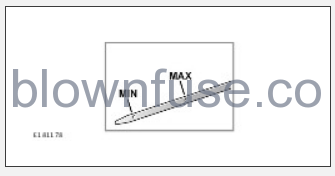
The graphic shown above is for illustrative purposes only.
The dipstick features minimum and maximum marks in order to help determine the oil level present in the engine. The marks can take the form of holes, lines or a hatched area.
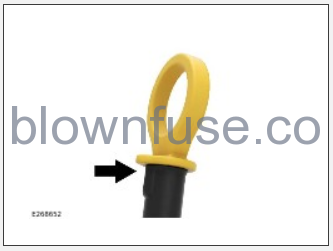
The dipstick on 2.0L petrol and diesel engines features a lug to aid correct fitment. Make sure the lug is correctly aligned with the groove in the dipstick tube. Failure to do this could result in the dipstick not fitting correctly and oil escaping from the engine.
Before checking the engine oil level, make sure that:
- The vehicle is stationary and the Electric Parking Brake (EPB) is applied.
- The vehicle is on level ground.
- The engine oil is cold.
NOTES
If it is necessary to check the oil level when the engine is hot, switch off the engine. Let the vehicle stand for 5 minutes to allow the oil to drain back into the sump. Do not start the engine.
The oil level can then be checked as follows:
- Withdraw the dipstick and wipe the blade clean with a lint-free cloth.
- Fully reinsert the dipstick and withdraw again to check the oil level.
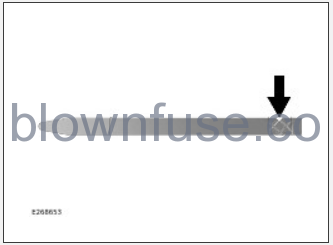
If the oil level lies within the hatched portion on the dipstick blade, do not add any more oil.
There is no requirement to top-up the oil unless the oil is at or below the lower mark.
If the oil level is below the lower mark, add 1 L of oil. Recheck the level and add more oil, if necessary.
Once the oil has reached the correct level on the dipstick, wait 5 minutes and recheck.
Engines without a dipstick feature an electronic oil level measurement system. The electronic oil level measurement system provides a method for checking the engine oil level using the touchscreen.
The engine oil level is not monitored when the engine is running, or when the vehicle is in motion.
Before checking the engine oil level, make sure that:
- The vehicle is stationary and the Electric Parking Brake (EPB) is applied.
- The vehicle is on level ground.
- The engine has reached its normal operating temperature.
- The engine has been switched off for 10 minutes to allow the engine oil level to stabilize.
The oil level can then be checked as follows:
- Touch the settings icon on the touchscreen.
- Touch the ALL soft key.
- Touch the Vehicle soft key.
- Touch the My Vehicle soft key.
- Touch the Service soft key.
The touchscreen displays the engine oil level indicator.
Touch the exit icon to return to the previously displayed screen.
TOPPING UP THE OIL
- The vehicle’s warranty may be invalidated if damage is caused by using oil that does not meet the required specification. See LUBRICANTS AND FLUIDS.
- Before driving off-road, top up the engine oil level to the maximum mark on the engine oil level dipstick. Failure to do so could result in an insufficient oil level when driving at certain angles off-road, which could cause damage to the engine.
- Failure to use an oil that meets the required specification could cause excessive engine wear, a build-up of sludge and deposits, and increased pollution. A resultant cause could be engine failure.
- Overfilling with oil could result in severe engine damage. Add engine oil in small quantities. Recheck the level to make sure the engine is not overfilled.
- Use of the correct oil specification is essential. Make sure the oil is suitable for the climatic conditions in which the vehicle is to be operated.
To top up the oil:
- Turn the oil filler cap counter-clockwise to remove.
- For engines with a dipstick:
Add oil to maintain the level between the MIN and MAX marks or notches on the dipstick.
- For engines with an electronic monitoring system:
Add oil, as indicated by the engine oil level indicator messages in the instrument panel.
- Clean up any oil spilled during topping up.
- Check the oil level again after 5 minutes.
- To refit the oil filler cap, turn the cap clockwise until a resistance is felt.
CHECKING THE COOLANT LEVEL
Running the engine without coolant causes serious engine damage.
If persistent coolant loss is noticed, seek qualified assistance immediately.
Check the coolant reservoir level at least every week. Check more frequently in high mileage or arduous conditions. Always check the level when the system is cold.
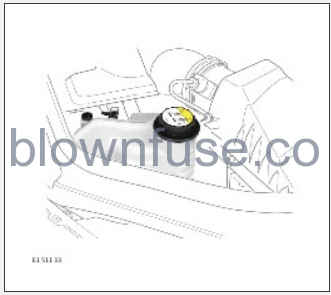
Make sure the coolant level remains between the MIN and MAX indicator marks on the side of the expansion tank.
If the coolant level has dropped suddenly, or by a large amount, arrange for the vehicle to be examined by qualified personnel. Consult a retailer/authorized repairer as soon as possible.
TOPPING UP THE COOLANT
- Never remove the coolant reservoir filler cap when the engine is hot. Escaping steam or scalding water could cause serious personal injury. Unscrew the filler cap slowly, allowing the pressure to escape before removing completely.
- Antifreeze is highly flammable. Do not allow antifreeze to come into contact with open flames or other sources of ignition, e.g., a hot engine. A fire may result.
- Antifreeze is poisonous and can be fatal if swallowed. Keep containers sealed and out of the reach of children. If consumption is suspected, seek medical attention immediately.
- If the fluid comes into contact with the skin or eyes, rinse immediately with plenty of water. Failure to do so may result to serious injury.
- When traveling in places where the water supply contains salt, always make sure to carry a supply of fresh (rain or distilled) water. Topping up with salt water causes serious engine damage.
- The use of non-approved antifreeze has an adverse effect on the engine’s cooling system and, therefore, engine durability. See LUBRICANTS AND FLUIDS.
- Antifreeze damages painted surfaces. Soak up any spillage with an absorbent cloth immediately, and wash the area with a mixture of car shampoo and water.
- Do not use any anti-leak products in the cooling system, as it causes damage to the vehicle.
Antifreeze contains important corrosion inhibitors. The antifreeze content of the coolant must be maintained at 50% to 60% all year round, not just in cold conditions. To make sure the anti-corrosion properties of the coolant are maintained, the antifreeze content should be checked once a year. The antifreeze should be completely replaced every 10 years, regardless of the distance traveled. Failure to do so may cause corrosion of the radiator and engine components. The specific gravity of a 50% antifreeze solution at 20°C is 1.068 and protects against frost down to -40°C.
To top up the coolant:
- Rotate the coolant reservoir filler cap counter-clockwise and remove.
- Top up to the MAX indicator mark on the side of the coolant reservoir. Use a mixture of 50% water and 50% antifreeze. See LUBRICANTS AND FLUIDS.
CAUTION
Make sure that the correct mixture of water and antifreeze is used. Failure to do so may cause damage to the vehicle. See LUBRICANTS AND FLUIDS.NOTES
In an emergency, and only if the approved antifreeze is unavailable, top up the cooling system with clean water. Be aware of the resultant reduction in frost protection. Do not top up or refill with conventional antifreeze formulations. If in doubt, consult a qualified technician. - To refit the coolant reservoir filler cap, rotate the filler cap clockwise, until the cap’s ratchet clicks at least three times.
CHECKING THE BRAKE FLUID LEVEL
- Seek qualified assistance immediately if brake pedal travel is unusually long, or if there is any significant loss of brake fluid. Driving under such conditions could result in extended stopping distances or complete brake failure.
- Brake fluid is highly toxic. Keep containers sealed and out of the reach of children. If accidental consumption of fluid is suspected, seek medical attention immediately.
- If the fluid comes into contact with the skin or eyes, rinse immediately with plenty of clean water.
- Brake fluid is highly flammable. Do not allow brake fluid to come into contact with open flames, a hot engine, or other sources of ignition. A fire may result.
- Do not drive the vehicle with the fluid level below the MIN mark.
- If the quantity of fluid in the brake reservoir drops below the recommended level, a red warning lamp in the instrument panel illuminates. See BRAKE (RED).
If the warning lamp illuminates while the vehicle is being driven, gently apply the brakes to stop the vehicle, as soon as safety permits. Check and top up the fluid level, if necessary.
With the vehicle on level ground, check the fluid level at least every week. Check more frequently in high mileage or arduous operating conditions.
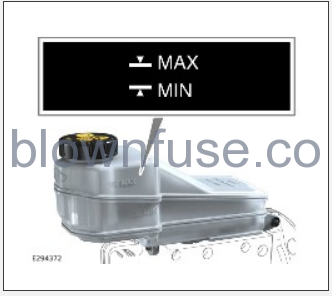
To check the brake fluid level:
- Remove the driver’s side under-bonnet cover. See UNDER-BONNET COVERS REMOVAL.
- Check the brake fluid level in the reservoir. The level should be between the MIN and the MAX marks.
The fluid level may drop slightly during normal use, as a result of brake pad wear. The fluid level should not be allowed to drop below the MIN mark.
TOPPING UP THE BRAKE FLUID
- Always use brake fluid that has the correct specification. See LUBRICANTS AND FLUIDS.
- Brake fluid damages painted surfaces. Soak up any spillage with an absorbent cloth immediately. Wash the area with a mixture of car shampoo and water.
- Only use new fluid from an airtight container. Fluid from open containers, or fluid previously bled from the system, would have absorbed moisture. Contaminated fluid adversely affects performance, and must not be used.
- Do not top up the brake fluid to the maximum mark unless the brake pads have been replaced. If unsure, seek qualified assistance.
To top up the brake fluid:
- Clean the brake fluid reservoir and the filler cap before removing, to prevent dirt from entering the reservoir.
- Rotate the reservoir filler cap counter-clockwise and remove.
- Top up the reservoir to at least the minimum mark.
- Rotate the reservoir filler cap clockwise to refit.
- Refit the under-bonnet cover. See UNDER-BONNET COVERS REFITTING.
CHECKING THE WASHER FLUID LEVEL
Some windscreen washer products are flammable, particularly if high or undiluted concentrations are exposed to sparking. Do not allow the windscreen washer fluid to come into contact with exposed flames or sources of ignition, as this can cause a fire or explosion.
If the vehicle is operated in temperatures below 4°C, use a windscreen washer fluid with frost protection. In cold weather, failure to use a windscreen washer fluid with frost protection could result in impaired vision and increase the risk of a vehicle crash.
Do not use antifreeze or a vinegar and water solution in the windscreen washer reservoir. Antifreeze damages painted surfaces, while vinegar can damage the windscreen washer pump.
Body panels may suffer discoloration as a result of windscreen washer fluid spillage. Take care to avoid spillage, particularly if an undiluted or high concentration is being used. If spillage occurs, wash the affected area immediately with water.
Only use approved windscreen washer fluid.
The washer fluid reservoir supplies the windscreen, rear screen, and headlight washer jets.
Check and top up the reservoir level at least every week. Always top up with screen washer fluid to prevent freezing.
Operate the washer controls periodically to check that the nozzles are clear and properly directed.
TOPPING UP THE WASHER FLUID
National or local regulations may restrict the use of Volatile Organic Compounds (VOCs) which are commonly used as antifreeze agents in windscreen washer fluid. A windscreen washer fluid with limited VOC content should be used only if it provides adequate freeze resistance for all climates in which the vehicle is operated.
The washer reservoir supplies the windscreen, rear screen, and headlight washer jets.
Check and top up the reservoir level at least every week. Always top up with screen washer fluid to prevent freezing.
Operate the washer controls periodically, to check that the nozzles are clear and properly directed.
Top up the windscreen washer fluid as follows:
- Clean the washer fluid filler cap before removing, to prevent dirt from entering the reservoir.
- Remove the filler cap.
- Top up the reservoir until the fluid is visible in the filler neck.
- Replace the filler cap.
